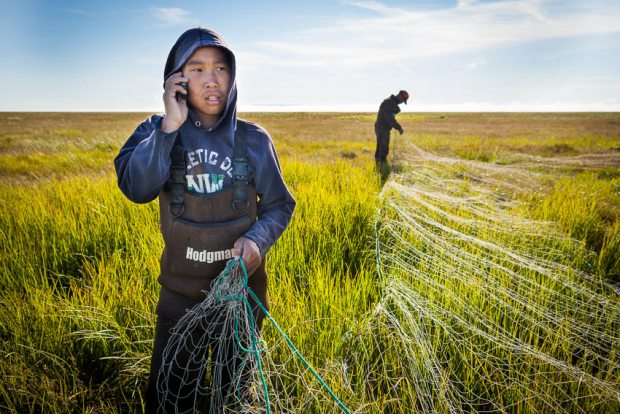Have king salmon fallen victim to cellphones on Alaska’s Kuskokwim River?

Loren Holmes photo
This season didn’t resemble the turmoil of 2012, when the Alaska Department of Fish and Game closed the fishery to protect the chinooks and a rebellion broke out along the river, only to be followed by a series of difficult trials in the spring. So a summer with people fishing and catching fish was a good thing.
‘Case of the missing salmon’
There is only one small problem. They caught too many kings, as the chinooks are also called. The spawning goal for the Kusko will not be reached this year, state fisheries biologist Kevin Schaberg said.
In Bethel, the regional hub near the lower end of the 702-mile-long river 400 miles west of Anchorage, people are talking about this as “the case of the missing salmon.”
Far upriver there is a different view. A resident of Sleetmute, some 305 miles upstream put bluntly:
“You want to know what the feeling is here? The feeling is they’ve been exterminated by the people in Bethel.”
“The last I saw up here in the Takotna (River) there were only about 90 kings that showed up,” added 77-year-old Ray Collins of McGrath. “Somehow, we’ve got to reduce the catch down in the lower river.”
McGrath is about 520 miles upstream on the Kuskokwim, some 200 miles farther than Sleetmute. The returns of salmon to the Taknota River near McGrath were all but wiped out by miners trying to feed themselves and their dog teams during the Alaska Gold Rush, but they came back in later years and runs by the end of the 20th century were in the range of 400 to 700 fish per year.
But they’ve been steadily declining over the past several years. The story is the same on most Kuskokwim tributaries. Downstream from McGrath at the George River, the Georgetown Tribal Council has watched king counts drop from 5,000 fish in 2004 to less than 3,000 in 2008 to fewer than 2,000 in 2010.
So far this year, 1,117 have returned. A few more could trickle in, but the run is basically over. The last time kings showed was Aug. 12 when two passed through the weir. During the previous week, three passed. Over two weeks, just 14 went by.
Downstream nets
With subsistence fishermen generally reporting good catches in the Bethel area during June and July, but few fish showing up in tributary spawning streams above the community of 6,000 in July and August, many are wondering what could possibly have happened.
In the Native Village of Napaimute some 160 miles upriver, Dave Cannon, the community’s environmental director, voices an obvious answer: The fish were caught in downstream nets.
This is where the cell phone enters the picture.
That technology has dramatically changed life along the river. Cell phones appear everywhere in rural Alaska now. Adults have taken to them the way children take to sweets. Rural Alaskans spend as much time talking and texting as do other Americans, and anyone who has been paying attention has probably noticed Americans spend a lot of time talking and texting.
Along the Kusko, the talk and the texts are often about where the salmon can be found. This has pretty much changed everything, said Cannon, a member of the Kuskokwim River Salmon Management Working Group.
Bigger, faster power boats long ago replaced motorized canoes on the Kusko, and efficient driftnets have been taking over for fixed, less-efficient setnets for years. Fish camps, which once took place around those setnet sites, are fading away as people elect to base themselves from homes in villages along the river.
The people of Bethel and the surrounding area, more than two thirds of them Alaska Native, are becoming more and more like the people of Anchorage, 90 percent of whom are non-Native. The residents of the largest city in the 49th state enjoy all the amenities of any other major urban area — until a friend texts them that sockeye salmon have hit the Kenai River in force. Then, tens of thousands of them grab dipnets and roar south on the Sterling and Seward highways, gathering on a Cook Inlet beach to scoop salmon out of the water. Fortunately for the fish, the dipnet is a very inefficient tool. Plenty of fish get past.
Do salmon stand a chance?
The drift net, on the other hand, is a very efficient tool. And when employed in certain key choke points along the Kusko, it is an even more efficient tool, according to state officials.
Bethel area fishermen know all about those choke points. They’ve been learning about them for years. And now they’ve got the technology to call in the troops when the fish show up. The salmon don’t stand much of a chance.
“It’s just gotten very efficient with good motors, good boats, and with things like cell phones and Facebook,” Cannon said. “Over time, fishing efficiency has increased.”
This is not a new problem in fisheries management.
From the Grand Banks off the U.S. East Coast to Icy Strait at the northern entrance of Southeast Alaska, fisheries managers have been time and again been ambushed by technological improvements that made fisheries more efficient. For years going into the 1970s, even as improvements in radar and sonar were changing the way people fished, state fisheries biologists assumed commercial trollers fishing with hooks and lines were just too inefficient to have an area-wide impact on fish passing through the Straits.
Then some researchers did an interception study and found, much to their surprise, that the fishermen had figured out what tools to use to find fish. And once they found them, they caught a lot. The troll fleet, as it turned out, was a lot more efficient than anyone thought. In some cases, trollers were catching 75 percent or more of the fish bound for streams throughout the northern end of the Panhandle.
As it turns out, subsistence fishermen on the Kuskokwim may have become even more efficient than those commercial fishermen in Southeast.
Overfishing only explanation
“Things looked fine early in the season,” Schaberg said. “It didn’t work out.”
Overfishing is the only real explanation.
Biologists are still crunching numbers. As of the moment, they don’t know how much they’ll miss the spawning goals by, and they remain unsure of the size of the subsistence harvest. A full report on the fishery is months away.
But Schaberg concedes everything is pointing toward a classic case of what has long been categorized as “the tragedy of the commons,” a concept outlined by ecologist Garrett Hardin’s in 1968.
It describes a situation where individuals, acting sensibly in their self interests, combine to destroy a resource vital to everyone.
It is good that people in the Bethel area have well- stocked larders of fish this year, everyone agrees. But it will be bad — very bad — if that means few fish return in three or four years, the biologists say. The failure to meet escapement goals is not a guarantee that future runs will crash. People in the region could get lucky. Extremely good ocean survival could render unmet spawning escapement goals meaningless.
But that is looking unlikely.
Ocean survival has been running in the opposite direction, not only for the Kuskokwim but for all Alaska king salmon streams. The spawning goal for the Kusko this year was lowered from 127,000 kings to a minimum of 65,000. Why? Because ocean survival was so poor in 2010, 2011 and last year that the kings came back in such low numbers that subsistence fishing had to be restricted.
The intent was to ensure the fishery went unrestricted this year. State biologists projected that 160,000 to 240,000 kings would return. In theory, that should have provided plenty for fishermen along the river, and still enough to meet spawning needs. In practice, it doesn’t appear to have worked out that way.
“Somehow we’ve got to reduce the catch down there in the lower river,” Collins said. “There are going to have to be restrictions next year. I would rather see them stop the drifting (with nets) in the open river when it narrows down.”
He suggests a return to shore-based set nets, which are less efficient, or even the fish wheels used long ago.
“Go to wheels or even dipping (dipnetting) where you could release the bigger females and keep smaller males. We’ve got to protect the bigger fish to get those eggs upstream.”
But he concedes these ideas are a hard sell.
“Because of the cost of gas, nobody wants to go far to check a wheel,” he said. “People aren’t in the fish camps either now because of that. That’s a difference.”
Times have changed, technology even more so.



